The material from the inner and outer solar systems is still found in meteorites. As indicated by the older hypothesis, the residue in the inner Solar System agglomerated to ever bigger lumps, gradually arriving at roughly the size of our Moon. Collisions of these planetary embryos at long last created the inward planets Mercury, Venus, Earth, and Mars.
Nonetheless, a more up-to-date hypothesis favors an alternate development process: millimeter-sized dust pebbles moved from the external Solar System towards the Sun. On their way, they were accumulated onto the planetary embryos of the internal Solar System, and bit by bit, expanded them to their current size.
Both theories are based on theoretical models and computer simulations. Both describe a possible path of planet formation.
But which one is correct? Which process took place? To answer these questions, scientists from the University of Münster (Germany), the Observatoire de la Cote d’Azur (France), the California Institute of Technology (USA), the Natural History Museum Berlin (Germany), and the Free University of Berlin (Germany) determined the exact composition of the rocky planets Earth and Mars.
Scientists presented a most comprehensive comparison of the isotopic composition of Earth, Mars, and pristine building material from the inner and outer Solar System. The results could alter our understanding of the process that formed the planets Mercury, Venus, Earth, and Mars.
Dr. Christoph Burkhardt of the University of Münster, the study’s first author, said, “We wanted to find out whether the building blocks of Earth and Mars originated in the outer or inner Solar System. To this end, the isotopes of the rare metals titanium, zirconium, and molybdenum found in minute traces in both planets’ outer, silicate-rich layers provide crucial clues. Isotopes are different varieties of the same element, which differ only in the weight of their atomic nucleus.”
Scientists assume that the distribution of the material in the early solar system and other metal isotopes was not even; it was based on the distance from the Sun. Hence, they hold crucial information about the origin of certain bodies ‘ building blocks in the early Solar System.
For reference, scientists used two types of meteorites. These meteorites generally found their way to Earth from the asteroid belt. Plus, they are mainly considered pristine material from the beginnings of the Solar System.
While so-called carbonaceous chondrites, which can contain up to a few percent carbons, originated beyond Jupiter’s orbit and only later relocated to the asteroid belt due to the influence of the growing gas giants, their more carbon-depleted cousins, the non-carbonaceous chondrites, are true children of the inner Solar System.
Scientists studied the precise isotopic composition of Earth’s accessible outer rock layers and both types of meteorites. However, there have been no comparably comprehensive analyses of Martian rocks.
Scientists examined samples from 17 Martian meteorites, which can be assigned to six typical types of Martian rock. They also investigated the abundances of three different metal isotopes.
The samples of Martian meteorites were first powdered and subjected to complex chemical pretreatment. Scientists then used a multi-collector plasma mass spectrometer to detect tiny amounts of titanium, zirconium, and molybdenum isotopes. Later, by performing computer simulations, scientists calculated the ratio in which building material found today in carbonaceous and non-carbonaceous chondrites must have been incorporated into Earth and Mars to reproduce their measured compositions.
While doing so, they considered two different phases of accretion to account for the different history of the titanium and zirconium isotopes and the molybdenum isotopes, respectively.
Their results show that the outer rock layers of Earth and Mars have little in common with the carbonaceous chondrites of the outer Solar System. They account for only about four percent of both planets’ original building blocks.
Prof. Dr. Thorsten Kleine of the University of Münster said, “If early Earth and Mars had mainly accreted dust grains from the outer Solar System, this value should be almost ten times higher. We thus cannot confirm this theory of the formation of the inner planets.”
Christoph Burkhardt said, “The composition of Earth and Mars does not exactly match the material of the non-carbonaceous chondrites either. The computer simulations suggest that another, different kind of building material must also have been in play.”
“The isotopic composition of this third type of building material as inferred by our computer simulations implies it must have originated in the innermost region of the Solar System.”
Thorsten Kleine said, “Since bodies from such proximity to the Sun were almost never scattered into the asteroid belt, this material was almost completely absorbed into the inner planets and thus did not occur in meteorites.”
“It is, so to speak, ‘lost building material’ to which we no longer have direct access today.”
Christoph Burkhardt said, “The surprising find does not change the consequences of the study for a theory of planet formation. The fact that Earth and Mars contain mainly material from the inner Solar System fits well with planet formation from the collisions of large bodies in the inner Solar System.”
Journal Reference:
- Christoph Burkhardt, Fridolin Spitzer et al. Terrestrial planet formation from lost inner solar system material, Science Advances, 22. Dezember 2021. DOI: 10.1126/sciadv.abj7601
